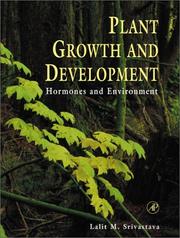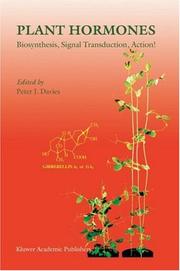| Listing 1 - 8 of 8 |
Sort by
|

ISBN: 9780080924304 0080924301 1299193021 9781299193024 9780080924298 0080924298 9780123865397 0123865395 0124502822 9780124502826 0080993621 9780080993621 0081007566 9780081007563 0128117907 9780128117903 9780124502833 0124502830 9780123865403 0123865409 0124502806 9780124502802 0124502814 9780124502819 0124502865 9780124502864 012450289X 9780124502895 0123739039 9780123739032 0124502873 9780124502871 9780080993621 9780081007563 9780128117903 9780081000236 0081000235 9780124171855 0124171850 012450275X 9780124502758 9780128148051 0128148055 0124502849 9780124502840 0124502881 9780124502888 Year: 1984 Publisher: Orlando Academic Press
Abstract | Keywords | Export | Availability | Bookmark
 Loading...
Loading...Choose an application
- Reference Manager
- EndNote
- RefWorks (Direct export to RefWorks)
Strategies and Tactics in Organic Synthesis
Organic compounds --- Synthesis. --- Alkaloids --- Cyclophanes --- Dodecahedrane --- Gibberellins --- Macrolides --- Prostaglandins --- Terpenes --- Transition state structure,pericyclic
Book
Abstract | Keywords | Export | Availability | Bookmark
 Loading...
Loading...Choose an application
- Reference Manager
- EndNote
- RefWorks (Direct export to RefWorks)
One of the goals of plant science is to improve agricultural sustainability, increasing yield, food diversity, and nutrition, while minimizing the negative impact on our environment. In response to internal and external cues, plant hormones control various aspects of plant growth and development. The wealth of our knowledge on plant hormones shall greatly advance sustainable agriculture.
Cytokinins --- auxins --- Gibberellins --- Light --- plant hormones --- strigolactones --- Abscisic Acid --- Brassinosteroids --- nitrate --- ethylene

ISBN: 012660570X 9786611755652 1281755656 0080514030 9780080514031 9780126605709 Year: 2002 Publisher: Amsterdam ; Boston : Academic Press,
Abstract | Keywords | Export | Availability | Bookmark
 Loading...
Loading...Choose an application
- Reference Manager
- EndNote
- RefWorks (Direct export to RefWorks)
This book provides current information on synthesis of plant hormones, how their concentrations are regulated, and how they modulate various plant processes. It details how plants sense and tolerate such factors as drought, salinity, and cold temperature, factors that limit plant productivity on earth. It also explains how plants sense two other environmental signals, light and gravity, and modify their developmental patterns in response to those signals. This book takes the reader from basic concepts to the most up-to-date thinking on these topics.* Provides clear synthesis and re
Growth (Plants) --- Plant hormones --- Plants --- 577.175.1 --- 581.14 --- 577.175.1 Plant hormones (phytohormones). Auxins. Gibberellins. Cytokinins --- Plant hormones (phytohormones). Auxins. Gibberellins. Cytokinins --- 581.14 Development --- Development --- Development of plants --- Plant development --- Developmental biology --- Hormones (Plants) --- Phytohormones --- Hormones --- Phytochemicals --- Plant regulators --- Plant growth --- Growth --- Plant physiology --- Meristems --- Plant growth-promoting rhizobacteria --- Rejuvenescence (Botany) --- Ontogeny --- Plant hormones. --- Development. --- Biología Avanzada (70981104) --- Bibliografía recomendada

ISBN: 0124502806 0323152937 129936540X 9780124502802 9780124502819 0124502814 Year: 1984 Publisher: Orlando : Academic Press, Inc.,
Abstract | Keywords | Export | Availability | Bookmark
 Loading...
Loading...Choose an application
- Reference Manager
- EndNote
- RefWorks (Direct export to RefWorks)
Strategies and Tactics In Organic Synthesis
547.057 --- Organic compounds --- -Compounds, Organic --- Organic chemicals --- Carbon compounds --- 547.057 Organic chemistry--?.057 --- Organic chemistry--?.057 --- Synthesis --- Chemistry, Organic --- Chemistry, Synthetic organic --- Organic synthesis (Chemistry) --- Synthetic organic chemistry --- Synthesis. --- -Synthesis --- Organic compounds - Synthesis --- Alkaloids --- Cyclophanes --- Dodecahedrane --- Gibberellins --- Macrolides --- Prostaglandins --- Terpenes --- Transition state structure,pericyclic

ISBN: 9781402026867 9781402026843 9781402026850 1402026862 1402026854 1402026846 9789401751278 9789402412420 Year: 2010 Publisher: Dordrecht Springer Netherlands
Abstract | Keywords | Export | Availability | Bookmark
 Loading...
Loading...Choose an application
- Reference Manager
- EndNote
- RefWorks (Direct export to RefWorks)
Plant hormones play a crucial role in controlling the way in which plants grow and develop. While metabolism provides the power and building blocks for plant life, it is the hormones that regulate the speed of growth of the individual parts and integrate them to produce the form that we recognize as a plant. This book is a description of these natural chemicals: how they are synthesized and metabolized, how they act at both the organismal and molecular levels, how we measure them, a description of some of the roles they play in regulating plant growth and development, and the prospects for the genetic engineering of hormone levels or responses in crop plants. This is an updated revision of the third edition of the highly acclaimed text. Thirty-three chapters, including two totally new chapters plus four chapter updates, written by a group of fifty-five international experts, provide the latest information on Plant Hormones, particularly with reference to such new topics as signal transduction, brassinosteroids, responses to disease, and expansins. The book is not a conference proceedings but a selected collection of carefully integrated and illustrated reviews describing our knowledge of plant hormones and the experimental work that is the foundation of this information. The Revised 3rd Edition adds important information that has emerged since the original publication of the 3rd edition. This includes information on the receptors for auxin, gibberellin, abscisic acid and jasmonates, in addition to new chapters on strigolactones, the branching hormones, and florigen, the flowering hormone.
Life Sciences. --- Plant Sciences. --- Life sciences. --- Botany. --- Sciences de la vie --- Botanique --- Plant hormones --- Growth (Plants) --- Plants --- Plant molecular biology --- Plantes --- Croissance (Plantes) --- Biologie moléculaire végétale --- Development --- Hormones --- Développement --- Growth (Plants). --- Plant hormones. --- Botany --- Earth & Environmental Sciences --- Plant Physiology --- Development. --- Planten moleculaire biologie --- Plantenhormonen --- Groei (planten) --- Plant molecular biology. --- Development of plants --- Plant development --- Plant growth --- Hormones (Plants) --- Phytohormones --- Molecular phytobiology --- Phytobiology, Molecular --- Growth --- 577.175.1 --- Plant hormones (phytohormones). Auxins. Gibberellins. Cytokinins --- 577.175.1 Plant hormones (phytohormones). Auxins. Gibberellins. Cytokinins --- Plant science. --- Developmental biology --- Molecular biology --- Phytochemicals --- Plant regulators --- Plant physiology --- Meristems --- Plant growth-promoting rhizobacteria --- Rejuvenescence (Botany) --- Ontogeny --- Botanical science --- Phytobiology --- Phytography --- Phytology --- Plant biology --- Plant science --- Biology --- Natural history --- Biosciences --- Sciences, Life --- Science --- Phytochemistry. Phytobiochemistry --- Plant physiology. Plant biophysics --- Plant embryology and development --- Planten ; moleculaire biologie --- Floristic botany --- Plants - Development --- Plantes - Hormones --- Plantes - Développement --- PLANT HORMONES --- PLANTS --- DEVELOPMENT --- MOLECULAR BIOLOGY
Book
Year: 2021 Publisher: Basel, Switzerland MDPI - Multidisciplinary Digital Publishing Institute
Abstract | Keywords | Export | Availability | Bookmark
 Loading...
Loading...Choose an application
- Reference Manager
- EndNote
- RefWorks (Direct export to RefWorks)
Gibberellins (GAs) and abscisic acid (ABA) are two phytohormones that antagonistically regulate plant growth, as well as several developmental processes from seed maturation and germination to flowering time, through hypocotyl elongation and root growth. In general, ABA and GAs inhibit and promote cell elongation and growth, respectively. Consequently, this mutual antagonism between GAs and ABA governs many developmental decisions in plants. In addition to its role as a growth and development modulator, ABA is primarily known for being a major player in the response and adaptation of plants to diverse abiotic stress conditions, including cold, heat, drought, salinity and flooding. Remarkably, different works have also recently pointed to a function for GAs in the control of some biological processes in response to stress. The selection of research and review papers of this book, mostly focused on ABA, covers a wide range of topics related to the most recent advances in the molecular mechanisms of ABA and GA functions in plants.
particle film technology --- xanthophylls --- VAZ cycle --- drought --- Vitis vinifera L. --- abscisic acid --- ABA --- ethylene --- pathogens --- plant immunity --- PYR1 --- salicylic acid --- Arabidopsis thaliana --- cell expansion --- gibberellins --- hypocotyl growth --- transcriptomic analysis --- plant hormones --- plant size --- receptor-like cytoplasmic kinase --- skotomorphogenesis --- Mediator complex --- transcription --- ABA signaling --- abiotic stress response --- grapevine --- stomata --- metabolism --- carbohydrates --- salinity --- chromatin remodeling --- guard cell --- osmotic stress --- protein phosphatase 2C --- stress memory --- transgenerational inheritance --- abscisic acid (ABA) --- flowering time --- Arabidopsis --- drought escape --- bZIP --- GIGANTEA --- CONSTANS --- FLOWERING LOCUS T --- FD --- citrus --- fruit maturation --- hormonal interplay --- sugars --- n/a
Book
ISBN: 3039281275 3039281267 Year: 2020 Publisher: MDPI - Multidisciplinary Digital Publishing Institute
Abstract | Keywords | Export | Availability | Bookmark
 Loading...
Loading...Choose an application
- Reference Manager
- EndNote
- RefWorks (Direct export to RefWorks)
The way plants grow and develop organs significantly impacts the overall performance and yield of crop plants. The basic knowledge now available in plant development has the potential to help breeders in generating plants with defined architectural features to improve productivity. Plant translational research effort has steadily increased over the last decade due to the huge increase in the availability of crop genomic resources and Arabidopsis-based sequence annotation systems. However, a consistent gap between fundamental and applied science has yet to be filled. One critical point often brought up is the unreadiness of developmental biologists on one side to foresee agricultural applications for their discoveries, and of the breeders to exploit gene function studies to apply to candidate gene approaches when advantageous on the other. In this book, both developmental biologists and breeders make a special effort to reconcile research on the basic principles of plant development and organogenesis with its applications to crop production and genetic improvement. Fundamental and applied science contributions intertwine and chase each other, giving the reader different but complementary perspectives from only apparently distant corners of the same world.
HD-Zip transcription factors --- Plant in vitro cultures --- plant breeding --- recalcitrant species --- CLV --- wounding --- semi-dwarf --- photoreceptors --- Arabidopsis thaliana --- root development --- morphogenesis --- embryogenesis --- cytokinin --- auxin conjugation --- molecular marker --- Development --- boundaries --- translational research --- proline biosynthesis --- Brassicaceae --- meristem formation --- phytohormones --- stem cells --- meristem --- cytoskeleton --- hydrogen peroxide --- ligule --- genetic improvement --- tree phase change --- Rht18 --- hairy roots --- WUS --- GRETCHEN HAGEN 3 (GH3) IAA-amido synthase group II --- photoperiod --- linkage map --- SAM --- ground tissue --- signaling --- differentiation --- protoxylem --- ambient temperature --- gibberellins --- molecular regulation --- proximodistal patterning --- wheat-rye hybrids --- RolD --- somatic cell selection --- flowering time --- plant development and organogenesis --- grass --- root --- wheat --- crop productivity --- genetic transformation --- regulatory networks --- light environment --- rol genes --- root plasticity --- morphogenic --- stem apical meristem --- auxin --- shoot meristem --- Arabidopsis --- organogenesis --- transformation --- Vasculature --- Organogenesis --- radial patterning --- plant development --- reduced height --- root apical meristem --- Asteraceae --- vernalization --- KNOX transcription factors --- locule --- plant cell and tissue culture --- Agrobacterium rhizogenes --- genes of reproductive isolation --- cell wall --- lateral root cap --- CLE --- auxin minimum --- age
Book
Year: 2021 Publisher: Basel, Switzerland MDPI - Multidisciplinary Digital Publishing Institute
Abstract | Keywords | Export | Availability | Bookmark
 Loading...
Loading...Choose an application
- Reference Manager
- EndNote
- RefWorks (Direct export to RefWorks)
Over the past decade, interest in plant biostimulants has been on the rise, compelled by the growing interest of researchers, extension specialists, private industries, and farmers in integrating these products in the array of environmentally friendly tools to secure improved crop performance, nutrient efficiency, product quality, and yield stability. Plant biostimulants include diverse organic and inorganic substances, natural compounds, and/or beneficial microorganisms such as humic acids, protein hydrolysates, seaweed and plant extracts, silicon, endophytic fungi like mycorrhizal fungi, and plant growth-promoting rhizobacteria belonging to the genera Azospirillum, Azotobacter, and Rhizobium. Other substances (e.g., chitosan and other biopolymers and inorganic compounds) can have biostimulant properties, but their classification within the group of biostimulants is still under consideration. Plant biostimulants are usually applied to high-value crops, mainly greenhouse crops, fruit trees and vines, open-field crops, flowers, and ornamentals to sustainably increase yield and product quality. The global biostimulant market is currently estimated at about $2.0 billion and is expected to reach $3.0 billion by 2021 at an annual growth rate of 13%. A growing interest in plant biostimulants from industries and scientists was demonstrated by the high number of published peer-reviewed articles, conferences, workshops, and symposia in the past ten years. This book compiles several original research articles, technology reports, methods, opinions, perspectives, and invited reviews and mini reviews dissecting the biostimulatory action of these natural compounds and substances and beneficial microorganisms on crops grown under optimal and suboptimal growing conditions (e.g., salinity, drought, nutrient deficiency and toxicity, heavy metal contaminations, waterlogging, and adverse soil pH conditions). Also included are contributions dealing with the effect as well as the molecular and physiological mechanisms of plant biostimulants on nutrient efficiency, product quality, and modulation of the microbial population both quantitatively and qualitatively. In addition, identification and understanding of the optimal method, time, rate of application and phenological stage for improving plant performance and resilience to stress as well as the best combinations of plant species/cultivar × environment × management practices are also reported. We strongly believe that high standard reflected in this compilation on the principles and practices of plant biostimulants will foster knowledge transfer among scientific communities, industries, and agronomists, and will enable a better understanding of the mode of action and application procedures of biostimulants in different cropping systems.
Crocus sativus L. --- biofertilization --- arbuscular mycorrhizal fungi --- antioxidant activity --- crocin --- picrocrocin --- polyphenols --- safranal --- Maize --- biostimulant --- root --- stress --- growth --- gene expression --- stem cuttings --- propagation --- root morphology traits --- indole-3-acetic acid (IAA) --- indole-3-butyric acid (IBA) --- gibberellins --- phenolic compounds --- nutrients --- nutraceutical potential --- soybean --- yield --- N organic fertilizer --- seaweed extract --- mycorrhizal inoculants --- phosphate-solubilizing microorganisms --- biofertilizers --- microorganism consortium --- biostimulants --- Crocus sativus --- Funneliformis mosseae --- glasshouse --- protected cultivation --- Rhizophagus intraradices --- substrate --- L-methionine --- L-tryptophan --- L-glycine --- lettuce --- nitrogen --- plant biostimulant --- environmental stress --- vegetables --- fruit quality --- plants biostimulants --- yielding --- Biostimulants --- Euglena gracilis --- algal polysaccharide --- β-glucan --- water stress --- tomato --- aeroponics --- Zea mays L --- lignohumate --- lignosulfonate --- biological activity --- nitrogen metabolism --- carbon metabolism --- proteins --- phenolics --- sugars --- Ascophyllum nodosum --- Solanum melongena --- heterostyly --- pollination efficiency --- soilless conditions --- abiotic stress --- alfalfa hydrolysate --- chitosan --- zinc --- ascorbic acid --- Fragaria x ananassa --- functional quality --- lycopene --- organic farming --- protein hydrolysate --- Solanum lycopersicum L. --- tropical plant extract --- fertilizer --- melatonin --- phytomelatonin --- plant protector --- plant stress --- Lactuca sativa L. --- legume-derived protein hydrolysate --- nitrate --- Septoria --- wheat --- Paraburkholderia phytofirmans --- thyme essential oil --- isotope --- phytoparasitic nematodes --- suppressiveness --- sustainable management --- anti-nutritional substances --- fat --- fibre --- morphotype --- protein --- corn --- imaging --- industrial crops --- maize --- next generation sequencing --- phenomics --- plant phenotyping --- row crops --- Bacillus subtilis --- carotenoids --- probiotics --- PGPR --- Mentha longifolia --- humic acid --- antioxidants --- arbuscular mycorrhizal symbiosis --- mycorrhizosphere --- AMF associated bacteria --- plant growth-promoting bacteria --- phosphate-solubilizing bacteria --- siderophore production --- soil enzymatic activity --- biological index fertility --- nitrogenase activity --- microelements fertilization (Ti, Si, B, Mo, Zn) --- seed coating --- cover crop --- vermicompost --- growth enhancement --- AM fungi --- PGPB --- water deficit --- common bean --- Glomus spp. --- organic acids --- pod quality --- seaweed extracts --- seed quality --- tocopherols --- total sugars --- bean --- amino acids --- phenols --- flavonoids --- microbial biostimulant --- non-microbial biostimulant --- Lactuca sativa L. var. longifolia --- mineral profile --- physiological mechanism --- photosynthesis --- biocontrol --- plant growth promotion --- soil inoculant --- Trichoderma --- Azotobacter --- Streptomyces --- deproteinized leaf juice --- fermentation --- lactic acid bacteria --- plant nutrition --- antioxidant capacity --- ornamental plants --- N fertilization --- nitrogen use efficiency --- leaf quality --- Spinacia oleracea L. --- sustainable agriculture --- Valerianella locusta L. --- isotopic labeling --- turfgrass --- humic acids --- leaf area index (LAI) --- specific leaf area (SLA) --- Soil Plant Analysis Development (SPAD) index --- tuber yield --- ultrasound-assisted water --- foliar spray --- Pterocladia capillacea --- bio-fertilizer --- growth parameters --- Jew’s Mallow --- CROPWAT model --- eco-friendly practices --- total ascorbic acid --- Mater-Bi® --- mineral composition --- SPAD index --- Bacillus thuringiensis --- Capsicum annuum --- microbiome --- strain-specific primer --- tracking --- sweet basil --- alfalfa brown juice --- biostimulation --- chlorophyll pigments --- histological changes --- humic substances --- protein hydrolysates --- silicon --- arbuscular mycorrhiza --- plant growth promoting rhizobacteria --- macroalgae --- microalgae --- abiotic stresses --- nutrient use efficiency --- physiological mechanisms
| Listing 1 - 8 of 8 |
Sort by
|

 Search
Search Feedback
Feedback About UniCat
About UniCat  Help
Help News
News